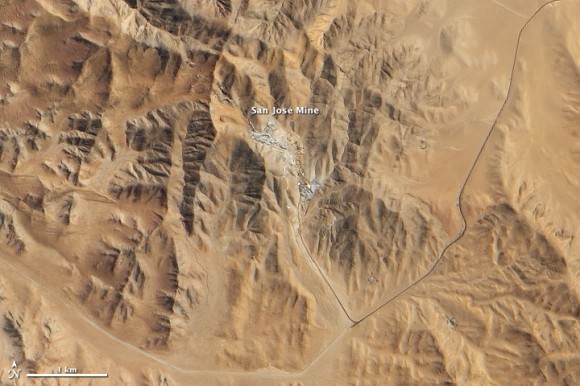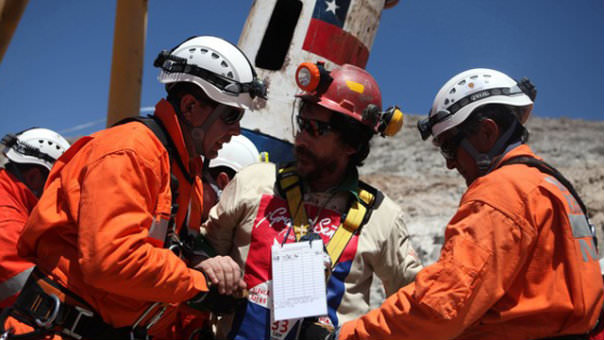[/caption]
The world has been transfixed by the rescue of 33 miners trapped nearly a kilometer (about a half a mile) underground in the San Jose mine near Copiapo, Chile. Seeing the men emerge from their 69-day-long ordeal has been emotional for everyone involved, as well as for those of us just watching from afar. But were it not for NASA, the rescue might not be going as smoothly and trouble-free as, thankfully, it has. NASA’s expertise in long duration space missions – which are similar in many respects to what the miners endured – as well as the space agency’s knowledge in specialized engineering and training for emergencies has been invaluable during the rescue operations. NASA provided suggestions regarding the rescue cages that were specially-designed to pull the trapped miners out of the narrow shaft that was drilled to rescue them, and also is providing on-site expert advice on medical, nutritional and behavioral health issues.
“What we brought to the table for the Chileans was our experience in behavior health support, not only in terms of the confinement and entrapment for that period of time but also what the miners and the families could experience once the miner had been rescued,” said Dr. Michael Duncan, who led the team of NASA experts who traveled to Chile, in answer to a question posed by Universe Today during a web chat. “In working with our astronauts and their families we prepare them beforehand and we support them during the mission and we support them after the astronaut returns. And I think our expertise in those areas was very helpful for the Chilean doctors and psychologists.”
Among NASA’s suggestions were an increased supplement of Vitamin D to normalize sleep patterns and developing an organized daily routine that includes exercise.
NASA also helped with diet suggestions which would help their well being during their entrapment, as well as making sure the miners would be well enough and trim enough to ride in the rescue capsule.
Indeed, the miners have emerged looking healthy and several have bounded out from the capsule, running to hug family and friends or greet the cheering crowd.
When the Chilean engineers decided a capsule was the best way to rescue 33 trapped miners, the NASA Engineering and Safety Center (NESC) provided about 75 recommendations, said Clinton Cragg, principal engineer at NESC, in an interview on WAVY.com. Most of those design elements found their way into the 4-meter (13 foot) 420 kg (926-pound) capsule dubbed “Phoenix.”
With the cramped, one-at-a-time ride taking 20 minutes or more, the miners are monitored by video on the way up for any sign of distress or panic. They have oxygen masks, dark glasses to protect their eyes from unfamiliar daylight and sweaters for the huge temperature differences from the heat of underground to the chilling cold in the high altitude Atacama Desert in Chile.

“The Chileans had a very limited set of requirements that they had given their own engineers with regards to how to design this cage, and that was primarily length, diameter, and weight,” said Duncan. “Looking at the video of the cage, some of these things they’ve certainly incorporated into their design.”

Now that the miners are safe, Duncan said each will be observed for any medical conditions that they may have developed. “Of course, we’re looking for things like skin infections or infections of the sinuses or the lungs,” he said during the web chat. “Something that they may have acquired due to exposure to the warm, humid and dusty conditions in the mine.”
In regards to the psychological health of the miners, Duncan said doctors and psychologists have been working with the miners and their families in an effort to educate them on these types of issues and the sudden celebrity that the miners now find themselves in, and they hope to try to prevent any future psychological issues from occurring.
The NASA team assisting the Chilean rescue included two medical doctors, Duncan and J.D Polk; psychologist Al Holland and Cragg.
“I am proud of the people of this agency who were able to bring the experience of spaceflight down to Earth when it was needed most,” said NASA Administrator Charlie Bolden in a statement. “As the drama of this rescue continues to unfold before us, we pray for the safe return of each and every miner.”
For a wonderful slideshow of images from the rescue, see this link to Reuters.
Sources: NASA, Washington Post Web chat, WAVY-TV NASA Earth Observatory,


NASA Administrator Charlie Bolden said: “As the drama of this rescue continues to unfold before us, we pray for the safe return of each and every miner.”
Pray? WTF?! I suppose that after the completion of the rescue effort, ‘God’ is going to get all the bloody credit for it too!
(Yeah, I know… I’m going to hell. 😛 )
Yep, many miners got on their knees to thank god for saving them. Many news media also reported it, too. A miner stated he saw god and satan in the tunnels–why didn’t god or satan “bring them out?” Gosh, who really saved them?
And, no media, including PBS-TV and NPR-radio added that NASA helped and had medical staff there, either! However, I will spot check MSNBC for any NASA mentions.
Correction, some news media did include NASA’s help in this rescue: FNC’s Van Susteren; others?
A NASA psychologist was interviewed today on the Canadian Broadcasting Corporation Noon News about NASA’s role in the rescue.
As someone who comes from an engineering family that can be traced back to the 19th cent. I am in awe of the techniques demonstrated by the drilling teams as well as the rescue capsule. Congratualtions to all concerned.
Has anyone thought of setting up a tour where people could be lowered into the mine to experience – to some extent – what it must have been like for those miners?
This area of the world must be fairly religious. All the interviewed miners were pretty wound up with religious fervor: “I waited so long for God. Thank you God for saving us. When I saw the capsule God sent us a was so happy etc etc.”
Not to mention every brand of Christianity in the region was extolling the virtues of their ministers, letting everyone know how their priests saved these miners.
I really don’t get people. Can someone explain to me why these rescuers and their tools aren’t getting 110% of the praise?
Carl Sagan must be rolling in his grave.
Guys – this is South America. If you’ve never visited the place let me tell you – it is Catholic to the hilt. Honestly – you simply cannot imagine how catholic until you go there. It is the most overtly religious place that I’ve ever been. The rescuers themselves would be praying and thanking God, so I don’t think that they’ll be too miffed if the miners do too…
I thought it was great that they gave God the credit! You don’t see enough of that in this world today. I’m thankful for the rescuers and the tools also but the rescuers were not the ones who kept them through the first day and then the next 17 days and then the rest of the 70 days. It was their God and their faith in Him. This was one of the BEST rescues ever and I attribute that to God and the rescuers. Leave out God and you just don’t have the same results!! Sorry that bothers you but I hope some day you will be able to see it. Thankfully NASA officials do and so do many who work there. I assume that is why they can come up with tools and equipment and direction they have been able to offer humanity today!!